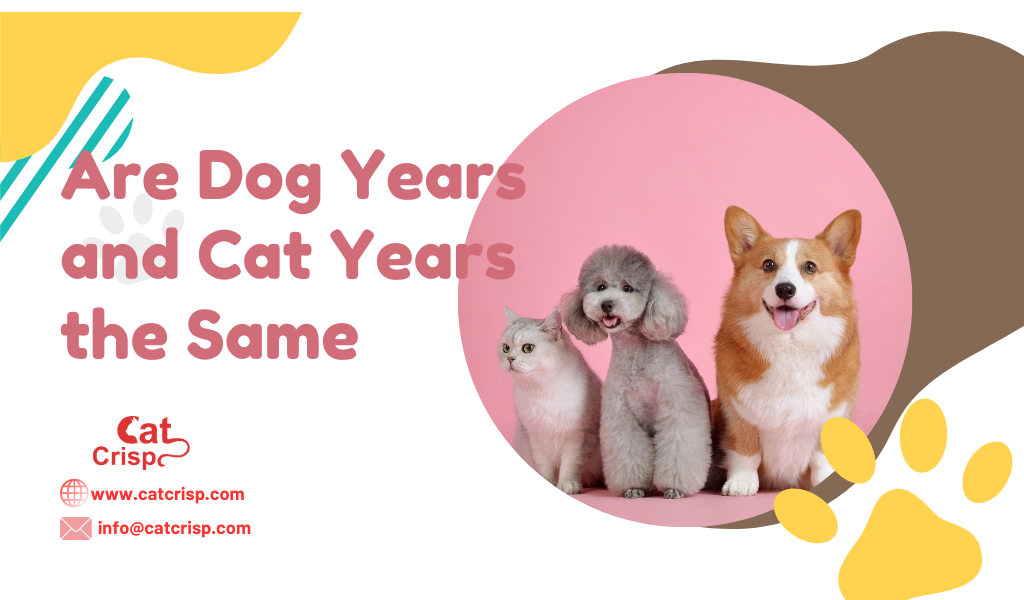If you have a dog or cat, you have often heard, “How old is my pet in human years?” It’s a common question among pet owners. And the answer frequently depends on the meanings of “dog years” and “cat years.” But there are lots of confusion to figure out the dog years or cat years.
Many of us have heard the old rule that one dog year equals seven human years, but is it the same for cats? Are dog years and cat years the same?
Table of Contents
ToggleClearing Up the Doubt "Are Dog Years and Cat Years the Same?"
The simple answer is no; dog years and cat years are not the same. Pet owners are often confused by the difference and worried about the lifespan and health of their animals.
Making educated decisions about your pet’s care can be improved by knowing how old they actually are. Also, it might help you understand their needs and behavior as they get older.
However, misunderstandings can result because of the lack of standard procedure for converting pet years to human years. Some individuals misjudge the age or age of their dogs, which has an impact on how they treat them.
Understanding the Concept of Pet Years
1. Dog Years
The popular belief that one dog year equals seven human years is an oversimplification. Dogs go through several life phases, much like people do, and the stages varies greatly based on the breed and size of the dog.
Larger dog breeds, for example, typically age more quickly than smaller ones.

- Puppyhood (0–1 year): Dogs grow and develop quickly in their first year of life. Most dogs reach the physical and social maturity of a 15-year-old human by the end of the first year.
- Adulthood (1-7 years):Dogs reach adulthood following their first year of life. Smaller breeds mature more slowly, while larger breeds age faster. For example, a 5-year-old Great Dane is considered middle-aged, whereas a 5-year-old Chihuahua is still relatively young.
- Senior Years (7+ years): Dogs are generally considered seniors at around 7 years old, but this can vary. While larger breeds may can achieve senior status by the age of five or six years, smaller breeds may not reach senior status until they are ten years old or older.
Also Read : Top 10 Tips for First Time Cat Owner
2. Cat Years
Cats age differently from dogs, and there is no standard conversion from cat years to human years. However, we can outline some general guidelines:

- Kittenhood (0-1 year): Like dogs, cats mature quickly in their first year. At this point, they are about the same age as a human being who is fifteen years old.
- Adulthood (1-10 years): Cats then enter a long period of adulthood. Unlike dogs,cats typically age at a more steady pace over those years.
Senior Years (10+ years): Cats are usually considered seniors at around 10 years old, although they can live well into their teens or even twenties. A 15-year-old cat is similar to a 76-year-old human.
Why the Difference?
The primary reason dog years and cat years are not the same lies in the biological and evolutionary differences between the species.
- Size and Lifespan: Generally, smaller animals have faster metabolisms and shorter lifespans. However, within the canine world, smaller breeds often outlive larger ones. For cats, the difference in lifespan based on size is less pronounced.
- Genetics: Both species have been selectively bred for various traits, impacting their aging processes. For instance, certain dog breeds are predisposed to specific health issues that can shorten their lifespan.
- Lifestyle Factors: Cats tend to live longer, especially when kept indoors, as they face fewer risks than outdoor cats. Dogs, depending on their size and breed, may require different levels of exercise and healthcare, impacting their longevity.
Practical Implications for Pet Owners
Understanding that dog years and cat years are not the same helps in making informed decisions about your pet’s care.

- Diet and Nutrition: Pets’ nutritional needs vary with age. While senior cats might need a diet that supports kidney function, older dogs might benefit from food that promotes joint health.
- Exercise and Mental Stimulation: Both dogs and cats need physical and mental stimulation, but the type and amount depend on their age and health status. For instance, a senior dog may need gentler walks, while an aging cat might benefit from interactive toys.
- Healthcare: Regular veterinary visits are crucial for catching age-related issues early. For example, older pets are more prone to arthritis, dental problems, and other chronic conditions.
Conclusion
In conclusion, while the concepts of “dog years” and “cat years” provide a useful framework for understanding our pets’ aging, it is evident that they are not equivalent. Dogs, particularly larger varieties, have a shorter life expectancy and age faster than cats.
Understanding these characteristics enables pet owners to give the greatest care for their pets throughout their lives, ensuring their health and happiness.
Whether you have a dog, a cat, or both, you must adjust their care to their individual needs, taking into account their species, breed, and age.
After all, the more we know about their aging processes, the better prepared we are to make their lives as fulfilling as possible. So, the next time someone asks, Are dog years and cat years the same?” you’ll not only have the answer but also the knowledge to explain why.

